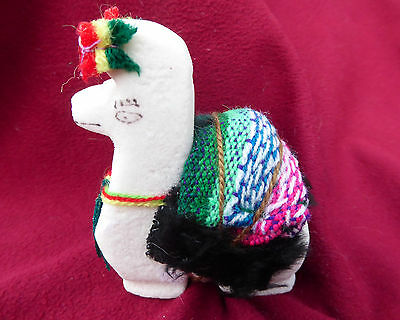-40%
From Bolivia’s Salt Flats: Hand Carved Salt Llama Figurine with Cloth Pack
$ 4.75
- Description
- Size Guide
Description
From Salt Flats in Bolivia:Hand Carved Salt Llama with Cloth Pack
Carved Figurine
2 3/4 inches tall
3.4 inches wide, not
counting pack
Nose to tail:
2 1/4 inches
Decoration
Eyes & Mouth Drawn
in Black
Black Blanket Saddle
Pink,
Blue, Green Pack
Red, Yellow, Green: Ear Bows & Front Flap
This charming hand carved llama was purchased at the Salt Flats near Potosi in Bolivia.
All handmade it is an interesting item for collectors– as durable as any pottery if stored or displayed in a dry, moderate temperature space.
About the Salt Flats
Salt flats are dried-up desert lakes. They form in closed hollows where rainfall cannot drain away. In a wet climate, a lake would form but, in a desert, the water is heated and evaporates into vapor faster than it is replenished by rain. The salt and minerals dissolved in the water are left behind as a solid layer. It looks like ice, has lots of
cracks
becomes the world's largest natural mirror, created when a thin film of water gathers on a vast plain of salt deposits.
Salar de Uyuni
(or Salar de Tunupais the world's largest salt flat at 4,086 square miles.
It is located in the Daniel Campos Province in Potosí in southwest Bolivia, near the crest of the Andes. Tourists and locals often visit the flats because of its eerie atmosphere:
Google Bolivia Salt Flats Images and then click on Images to see the cool pictures taken there.
Aymara legend tells that the mountains Tunupa, Kusku and Kusina, which surround the Salar, were giant people. Tunupa married Kusku, but Kusku ran away from her with Kusina. Grieving Tunupa started to cry while breast-feeding her son. Her tears mixed with milk and formed the Salar. Many locals consider the Tunupa an important deity and say that the place should be called Salar de Tunupa rather than Salar de Uyuni.
About Llamas
The llama is the national animal of Bolivia. The llama (pronounced
ya-ma"
not
la-ma
) has been bred and used as a pack animal by indigenous peoples of the Andes for thousands of years. It is related to the alpaca, the vicuña, and the guanaco. All are camelids.
They are very tough animals and the Incas used them as pack animals for thousands of years because they are very strong and surefooted on the rocky paths of the mountains and can carry very heavy loads.
Their wool is used for making woven Bolivian clothing like sweaters, gloves, winter caps, and coats because it is very thermal.
Llamas have been a part of Andean and Incan culture for thousands of years and the Aymaras and Quechuas use them in their rituals too. For example, when they build a new house or building they bury an unborn fetus under the cornerstone of the new house that will be built. They believe that by giving Mother Nature (they call her Pachamama) the fetus she will bring them health, wealth, happiness and safety in their new house or building.
This salt llama is guaranteed not to spit.
When angry real llamas spit a disgusting gooey stuff at you that's kind of green so you have to be careful about getting too close to them.
The sound of the llama making groaning noises or going
mwa
i is often a sign of fear or anger. If agitated, a llama will lay its ears back. One may determine how agitated the llama is by the materials in the spit. The more irritated the llama is, the further back into each of the three stomach compartments it will try to draw materials from for its spit. You may have guessed my kids were fascinated by spitting llamas.
About Red, Yellow, and Green
These three colors appear as three horizontal stripes on the flag of Bolivia.
Red symbolizes the brave soldiers of Bolivia, green for fertility, and yellow as the nation's mineral deposits. The current flag was adopted in 1851. It displays the three horizontal stripes, with the Bolivian coat of arms in the center.
~ BONNIE'S TRAVEL TREASURES
~
PLEASE NOTE THAT WE ARE A
PAYPAL ONLY
SELLER
~
SALES are limited to the UNITED STATES and CANADA only
~ COMBINED SHIPPING DISCOUNT for multiple items sent in the same package
(First place ALL selected items in eBay shopping cart, then use PayPal.)
~ PLEASE NOTE that we are a PAYPAL ONLY seller
~
PLEASE remit payment WITHIN 7 DAYS of purchase













